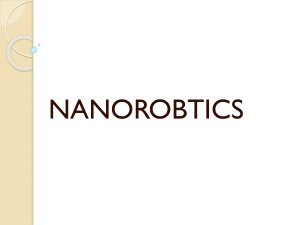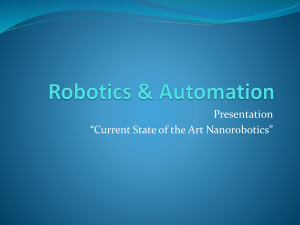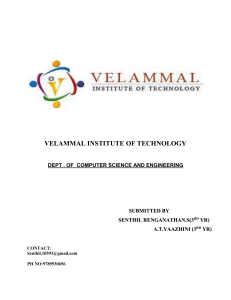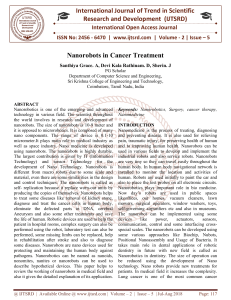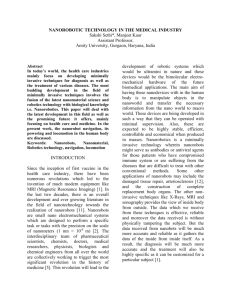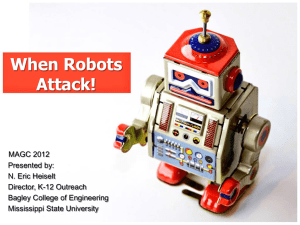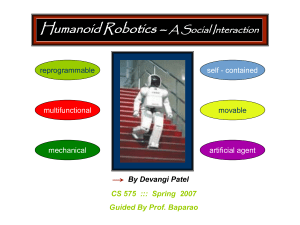NANOROBOTS-THE HEART SURGEON
advertisement
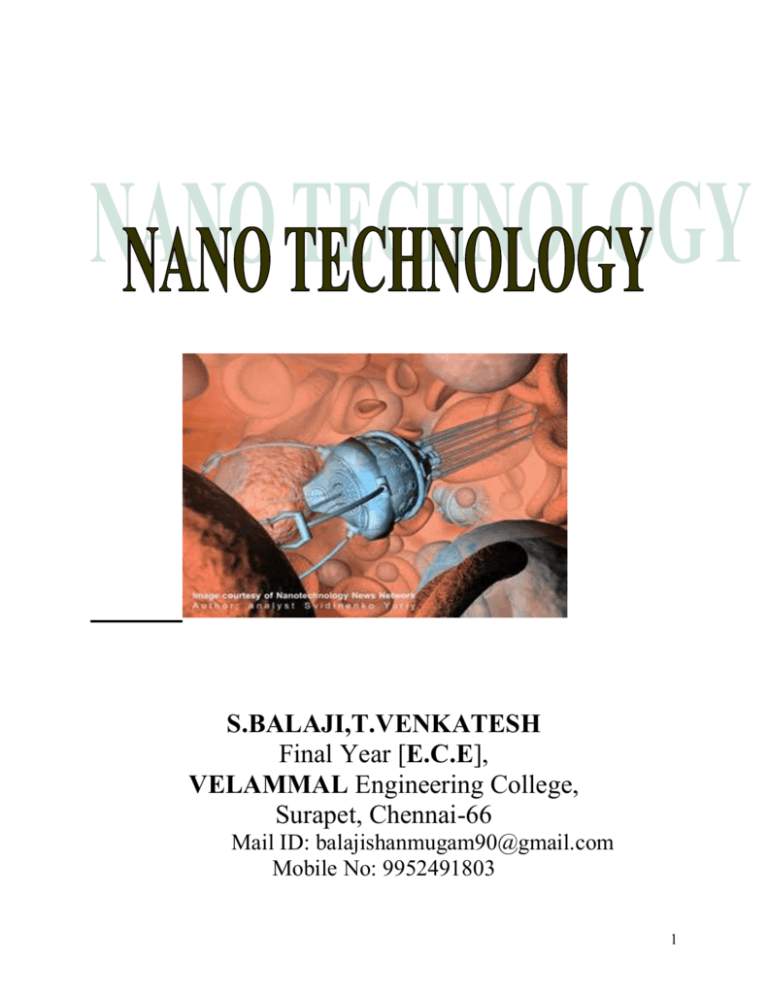
S.BALAJI,T.VENKATESH Final Year [E.C.E], VELAMMAL Engineering College, Surapet, Chennai-66 Mail ID: balajishanmugam90@gmail.com Mobile No: 9952491803 1 NANOROBOTS- THE HEART SURGEON ABSTRACT: MAIN PAPER: Competition grows everyday. Today man is forced to compete against machines. This develops stress and human body is subjected to various levels of trauma. The heart attacks become so common and the affected rate increases till date. Main reasons for this would be improper diet, tension and excess of cholesterol, which blocks the arteries and not allowing the blood to pass through them hence causing heart attack. This usually occurs when a blood clot forms inside a coronary artery at the site of an atherosclerotic plaque (blood clots on the roughened plaque). It is difficult to estimate exactly how common heart attacks are because as many as 200,000 to 300,000 people in the United States die each year before medical help is sought. It is estimated that approximately 1 million patients visit the hospital each year with a heart attack. About 1 out of every 5 deaths are due to a heart attack. Present day treatment includes surgeries which are considered outdated when compared to today’s technology. Heart blocks are caused due to the reason above. Current diagnostic measures include painful processes like the angiogram. The treatment for the block is also extremely dangerous, time consuming and painful. Angioplasty, although having the higher success rate, is old fashioned. Today’s technology promises a lot more than the insertion of a thin tube into the blood vessels. Nanorobots can be used in this process of curing heart blocks. NANOROBOTS: These nanoscale devices are able to perform higher with reduced time researches in nanotechnology brought newer approaches in the field of medicine. This paper focus on the employment of nanorobots for removing the heart blocks in more effective and accurate manner. Nanotechnology promise to be a pathway for the future. This paper focuses the causes of heart blocks, the current process of diagnostics and therapy. Later the idea of curing these heart blocks using nanorobots is discussed in a theoretical and imaginative approach. CHOLESTEROLS: Cholesterols are biochemical compound which are carried by lipoproteins found in blood and are essential for the normal functioning of the body to a certain extent. Cholesterol is fat like substance (lipids). These are chemical compounds of glycerol and unsaturated acid. Cholesterols found in the human body are of two types. They are Low Density Lipids (LDL) High Density Lipids (HDL) 2 HDLS: Harmless, highly stable and are disposed off from the body effectively. They don’t stick to the walls of the blood vessels. Actually HDLs help in carrying the bad cholesterols from the blood stream to the liver from where it gets disposed. These contain more of proteins and less fat. LDLS: Contain more fat and less protein. What determines the blood level of LDL and why is the level dangerous? Answer emerge from the study of specified proteins called LDL receptors that projects from the surface of animal cells. The receptors bind LDL particals and extract them from the fluid that bathes the cells, the LDL is taken into the cells and broken down yielding its cholesterol to serve each cells need. FUNCTIONS OF CHOLESTEROL: RECOMMENDED STANDARD FOR THE DESIRED BLOOD: Cholesterol of low risk contains: Total blood cholesterol (TBC) level to be less than 200 mg/dl and Total HDL to be 40 mg/dl or higher HIGH CHOLESTEROL: Level ranges for TBC>240mg/dl PRESENT DAY TREATMENT (angiogram and angioplasty): LDL on lump of deposition closes into the diameter of the blood vessel. So as the concentration increases, the diameter of the blood vessel decreases. Hence the blood transportation to or from the heart is affected. ANGIOGRAM: THE Assists in manufacture of hormones or vitamin D. Break down carbohydrates and proteins. Help from a protective coating around nerves. Build cell walls and to produce bile. 3 The above problems intensity is measured by a method known as angiogram. here a small tube of diameter of about few micrometer with a catheter(flexible tube inserted into the body for injecting or draining away fluid) at the end is used. This is introduced into the veins at the thigh and up to the pericardium. This catheter injects a radioactive fluid into the blood stream, the flow of which is monitored by a continuous X-ray. When this fluid flows through the block, there will be a contraction in the thickness of the fluid line monitored by the X-ray. This contraction indicates the location of the block. Once the block is located, it is removed by a method known as angioplasty. ANGIOPLASTY: Here the end of the catheter has a deflected balloon. This balloon is positioned under the block and inflated, so that the block bursts and is carried away through the blood stream. The blocked area is covered with a one way inflatable metal cylinder that is attached on the outside of the balloon to prevent the recursion of the block. As the balloon is inflated the cylinder attains shapes and locked on attaining maximum expansibility. This method is known as balloon angioplasty. NANOROBOTS: Nanorobots are nano devices that may be about 3 to 5 microns in size. The individual parts used to make those nanorobots may be of 1 to 200nm in size. Mainly made of carbon and may be given a coating of diamond, which is the most and toughest material ever known. The 4 nanorobots can be used for variety of purposes DIAGRAM OF NANOROBOTS WHEN COMPARED WITH RBC’S pressure sensors acoustic sensors chemo sensors smart sensors Nanorobots equipped with nanolasers to serve the block after confirmation in order to prevent the recurrence of the block, molecular synthesis is carried out (i.e.) nanorobots fills the burnt gap with fresh flawless cells synthesized by the robots themselves. This process is known as molecular synthesis. THE ACTUAL PROCESS: Sensor robots that navigates other robots through the blood stream: 1) All the three types of nanorobots needed for the process are suspended in a liquid matrix and injected into blood vessels of the patient. 2) Acoustic sensors in sensor robots get activated soon and begin navigating the army of robots through the blood stream to the pericardium. 3) Simultaneously, the smart sensors present in the sensor robots, get activated and form a closed ad-hoc network connecting all the robots. 4) This is very essential in order to guide all the nanorobots to the desired location. Nanorobots as a heart surgeon should carry out certain steps and finally solve the problem. The concepts involve three steps. They are Locate the block Serve the block provide molecular synthesis SOPHISTICATED METHOD: The most sophisticated type of diagnosis is done here by the sensor robots i.e. diagnosis inside the human body. These sensors on reaching the periphery of the heart scan the pericardial vessels for blocks and locate the spot exactly. Nanorobots with nanosensors to locate the block. These robots will need four kinds of nanosensors 5 3) 4) Sensor robots that navigate the other robots through the blood stream. 5) OPERATIONS: OPERATION STARTS: 1) The pressure sensors mounted on the sensor robots, scan the blood vessels for variation in the blood pressure. 2) This will act as the first confirmation. 3) This scanning for pressure variations is necessary as in the region of the block, there will be a constriction of blood vessel and hence a rise in the blood pressure compared to that existing in the nearby areas. 4) These sensors will generate a report of the potential areas of heart block. Based on the pressure mapping of the blood vessels. OPERATION PROCEEDS: 1) The second confirmation comes from chemo sensors. 2) These sensors scan the region they traverse for the chemical composition of the cholesterols. That is. The sensors differentiate the 6) cholesterol compounds accumulated on the walls of the blood vessels from the actual composition of the tissues of the blood vessels. In this way the block can be identified accurately. All these information are transmitted through the ad-hoc network formed by all the smart sensors and can be constantly viewed by the doctors monitoring the entire process. After successful location of the block the second type of nanorobots those equipped with nanoscalars comes into picture. These lasers like the robots themselves can be powered by the body itself by means of kinetic energy of the flowing blood, pressure of the blood flow etc thus laser can be powered by the most ingenious ways imaginable. These laser robots on activation based on the information flow through the network effectively burn down the block. OPERATION SUCCEEDS: 1) The final leg of the operation is the responsibility of the molecular synthesizers. 2) These nanorobots, take the required biochemical substances from the blood or surrounding tissues, and the synthesize the cells of the blood vessels in order to seal the area of the block. 3) These cells are placed in the affected region. 4) And as a result, we have a whole new region of blood vessel that is completely free from the threat of another block. 6 ADVANTAGES: Fast process Results are accurate, as the scale of operation is small. Involves less psychological strain compared to angioplasty. Harmful ray attack is reduced. Advanced and reliable technology. Aftereffects are eliminated. DISADVANTAGES: Expensive technology Practical implementation is some what difficult. Technology problems such as artificial reconstruction and artificial intelligence which results in robots going out of control of humans. CONCLUSION: The influence of nanorobots in the performance heart surgery is found to be effective and a reliable means of treatment. As the construction of nano robots is under progress, the ideas explained here could not be implemented at present. But it is sure that ideas will be put into action within a period, which is too far! 7

